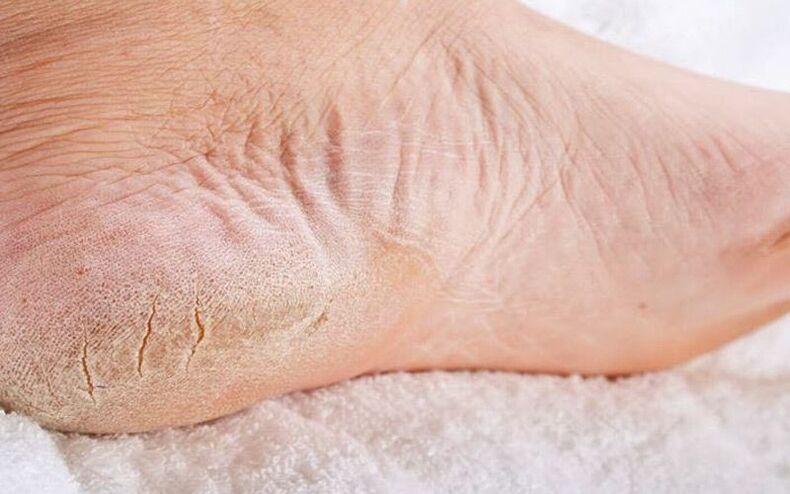
A fungal infection very often affects the toes or nails. This disease affects adults and children. To prevent the pathology from becoming chronic, you need to know the signs of athlete's foot and what such a disease looks like.
Main symptoms of the disease
Of all skin diseases, mycosis of the feet is the most common. You can become infected with the disease if you ignore basic hygiene rules. Sometimes it is very difficult to cure a fungus.
Athlete's foot begins and develops in each person in their own way. Here are the most common signs you can identify athlete's foot:
- characteristic cracks appear between the toes;
- You can tell that a fungus has appeared by the characteristic itching on the feet and between the toes;
- the skin of the feet is very dry, it often flakes and becomes rough;
- Blisters appear between the fingers and burst when destroyed;
- the infection can spread to neighboring areas;
- Reddish spots appear on the skin, causing significant discomfort.
- You can also recognize athlete's foot by its unpleasant smell.
At the first symptoms of the disease, you should consult a dermatologist immediately. If you do not do this in advance, treating the fungus will become significantly more difficult.
Signs of fungal infection depending on the type of pathogen
This disease is caused by different types of pathogens. The symptoms of foot damage vary from case to case.
- When yeast develops on the feet, the nail gradually becomes thinner and separates from the nail bed. The skin on the foot is hyperemic (takes on a red hue).
- With the development of epidermophytes, the nail turns yellow and becomes covered with spots. The skin on the feet peels off and an unpleasant odor appears. A characteristic symptom of this type of fungus is increased dryness of the skin.
- When mold appears, the nail plate may suddenly change color. If the pathogen gradually spreads to the entire foot, the skin becomes discolored. A person suffers from itching and the skin may become cracked. In this case, pain and other unpleasant sensations occur when walking.
Only a doctor can determine the type of pathogen. This is not possible at home. And if you self-medicate, you can only harm yourself. Your legs suffer as a result and the skin fungus continues to spread.

Signs of some species of mushrooms
Depending on the affected area and degree of development, various forms of pathology are distinguished. The symptoms are different in each case. Knowing the first signs of foot disease will allow you to start treating mycoses in a timely manner.
- Interdigital dermatophytosis is the most common stage of the disease. Things get more active in spring and summer, when your feet sweat the most. Cracks and wounds appear between the fingers. You may notice the presence of scales on their skin. The foot looks absolutely healthy. Often a person feels itching.
- The deleted form appears the least pronounced. Peeling can be felt between the fingers. At this stage of the disease, a pungent, unpleasant odor spreads from the feet: It is caused by increased bacterial activity.
The disease can occur in different forms. Let's get acquainted with their signs so that we know how to recognize fungus on the feet and, if it develops, begin treatment. It should be borne in mind that in the advanced stage of the disease the nail is completely destroyed. It is almost impossible to restore it.
Squamous cell carcinoma type
This fungus is characterized by severe shedding of the epidermis. In addition, the areas of skin between the toes and the side of the foot are most affected. There are no signs of the inflammatory process. In the photo of the first signs of athlete's foot, areas of hyperemia can be seen. Squamous cell carcinoma looks like this:
- the stratum corneum thickens;
- the skin shines, sometimes it becomes thick;
- the pattern on the skin becomes clearer;
- the fungus gradually spreads to the fingers and the entire foot, affecting the nails;
- sometimes lamellar scales appear on the epidermis;
- The patient does not feel any further unpleasant sensations.
Dyshidrotic type
This fungus causes small, fluid-filled blisters to form on the skin. They are usually found on the side of the foot. Then they gradually move to the inside of the fingers. How to recognize dyshidrotic type athlete's foot:
- the bubble is usually single, but if there are many of them, they merge into one large one;
- If left untreated, the fluid in the blisters will gradually darken;
- When the bubble bursts, an erosion with a crust appears in its place.
This type of athlete's foot carries a very high risk of bacterial infection. The infection enters the body through open skin lesions.
Intertriginous type
This type of mushroom is the most common. At first the person feels no symptoms. Up to a certain point, the skin on the toes does not change. Cracks and layers then appear. The skin is not affected, but it may sweat.
Candidiasis of the feet
The characteristic symptoms of this fungal infection are as follows:
- the lesion is the 3rd or 4th toe;
- the skin is red and swollen;
- A blister forms around the lesion where there is a peeled layer of skin;
- There are pustules and blisters nearby.
If a bacterial infection enters the affected area, it leads to an increase in the local temperature. Swelling can be seen on the skin of the legs. In severe cases, general hyperthermia occurs.
Signs of a fungal nail infection
A person's toenails can also be affected. The disease can be distinguished by the following symptoms.
- Significant color change of the nail plate. Depending on the type of pathology of the patient, the nail takes on different shades. Sometimes it can change only part of the nail plate.
- Nail crumbles. It only occurs in advanced stages. If the nail is completely infected, it will be destroyed.
- Changes in nail structure.
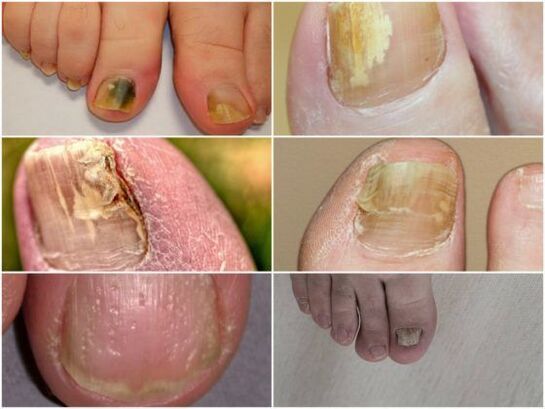
There are different types of onychomycosis, a fungal infection of the nails.
- Atrophic appearance. The nail plate looks very thin. It becomes darker and sometimes takes on a gray-brown color. The nail gradually separates from its nail bed. The underlying skin becomes calloused and loose.
- In the normotrophic form of athlete's foot, the plate changes color. Spots appear on it - white, yellow, green and even black. The structure of the nail is not affected.
- In the hypertrophic form, the plate gradually becomes thicker and porous. The affected area looks very unsightly and in some cases causes pain when walking. It crumbles on the sides and collapses without treatment.
Some types of onychomycosis
Depending on the degree of spread of the disease, its forms are distinguished.
- The most common is lateral onychomycosis. A small yellow spot initially appears on the free edge of the nail. In the future you will notice how it increases and the nail plate becomes thicker. When walking, a person feels discomfort. The spread of an unpleasant odor is noticeable. Lateral onychomycosis is difficult to treat.
- In superficial onychomycosis, only the upper layers of the plates are damaged. It doesn't thicken, but it does become chalky over time.
- The rarest form of the disease is subungual onychomycosis. The skin thickens noticeably in the nail fold. The nail turns white and loses its transparency.
General treatment principles
Any treatment of a pathology begins with the diagnosis. Only then can a suitable remedy be prescribed. Self-medication usually leads to a worsening of the condition of the legs. Let's get acquainted with the most common therapy methods.
- At the first signs of a fungal infection, special varnishes, plasters, ointments and sprays are used. They must be used for a long period of time and according to the instructions.
- If local therapy is ineffective, complex antifungal drugs are prescribed. They are used orally.
- Surgical removal of the affected nail.
- Laser therapy.
- In advanced forms of the disease, systemic medications are prescribed.
By observing the rules of hygiene, you can avoid the occurrence of an unpleasant disease. You should avoid using other people's personal care products (towels, slippers). At the first signs of illness, you should consult a doctor immediately.
Types of mycoses
Fungal infections of the feet usually occur between the toes. It is caused by different types of fungi. This problem is most common in adults because children's sweat can defuse the fungus.
Mycotic lesions can be of different types:
- Candidiasis – occurs when the body's resistance decreases, most often in women;
- Epidermophytosis is an exclusively "male" disease caused by excessive sweating;
- Rubromycosis is a highly contagious form that can occur in young children.
Signs and forms of the disease
The signs of a fungal infection may vary depending on the patient's age, the state of the immune system and the type of blood circulation.
In a person with a strong immune system, the fungus can remain on the skin for several months without showing up. Mild itching and slight redness of the skin may occur.
Treatment and best remedies
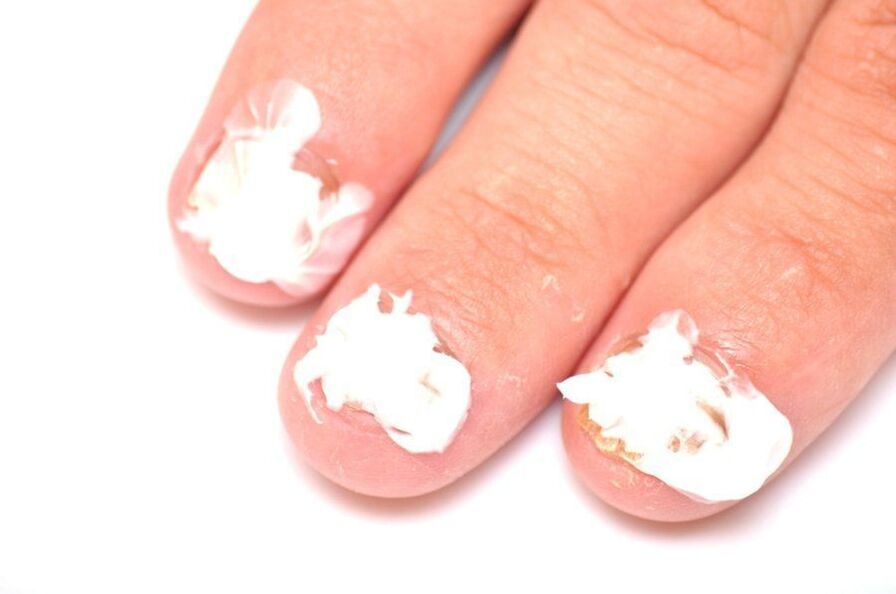
Advanced mycosis is treated with fungicidal tablets and antifungal ointments. The latter are used after washing and drying the feet.
It is recommended to use folk remedies only in the initial stages of the disease, as well as to relieve itching. They must be used with extreme caution as some are corrosive to the skin and can cause burns.
As for traditional medicine, its use is at the patient's own risk. Particular care should be taken when using formulations containing vinegar, celandine or manganese, as this can cause skin burns.
In parallel with drug treatment, you can use baths with oak bark, chamomile or sage. A soda bath effectively relieves itching.
Precautions
Although there are effective and inexpensive treatments for athlete's foot on the market, it is best not to let the problem arise. Prevention of a fungal infection consists of:
- in daily hygiene;
- Wearing individual shoes (especially in public showers, baths and swimming pools);
- regularly treat the inside of shoes with ammonia;
- daily change of socks;
- Strengthening and maintaining immunity.
These are basic, simple measures that anyone can implement. However, if an infection occurs, in order to prevent a relapse, it is necessary to treat athlete's foot with medication for another 14 days after all symptoms of mycosis have completely disappeared.
Athlete's foot: symptoms and treatment, photo of athlete's foot
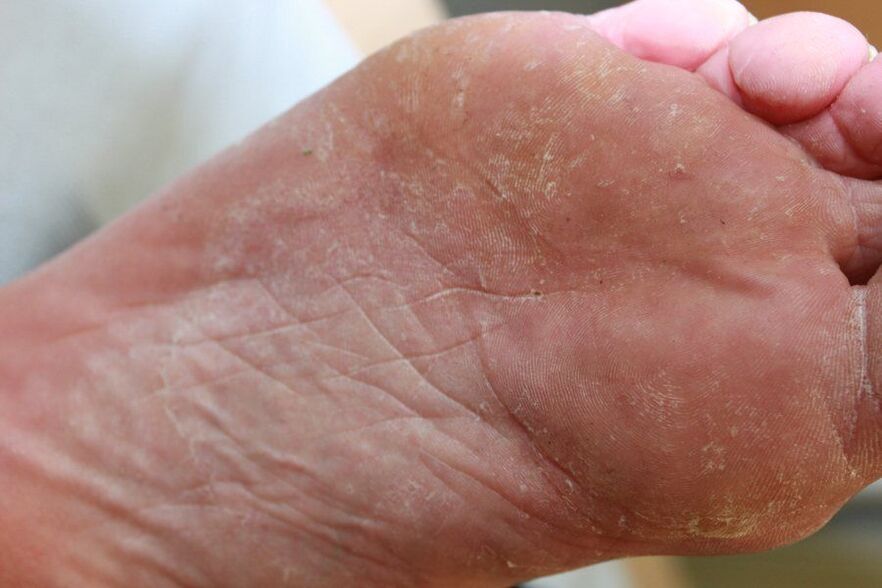
Athlete's foot is one of the most common diseases in dermatological practice. It occurs primarily in cultures where it is common to wear shoes most of the time and affects up to 70% of the adult population.
Most often, athlete's foot is observed in older people, but also in those whose immunity is significantly weakened, for example, with diabetes, AIDS, circulatory disorders in the lower extremities and other diseases of this type.
The term "fungus or mycosis of the foot" often refers to damage to the skin on the soles of the feet, the nails and the spaces between the toes caused by fungal mycelium.
pathogens
Among the numerous types of fungi, the most important pathogens that cause foot mycosis are the following:

- Trichophyton rubrum,
- Trichophyton mentagrophytes,
- Epidermophyton floccosum.
Other pathogens causing fungal infections of the feet that are not so common:
- Trichophyton tonsurans is the causative agent of mycoses in children in America.
- candida,
- Scytalidium hyalinum,
- Scytalidium dimidiatum.
All pathogens of fungal infections have adapted to parasitize in the stratum corneum of the skin and produce special enzymes there that break down keratin. In addition, their membranes (cell walls) contain mananes - special substances that suppress local immunity and contribute to the development of chronic inflammation.
Routes of infection and factors contributing to the disease
It is believed that some types of athlete's foot are able to maintain viability in exfoliated skin scales for a year. To become infected with a fungus, it is enough for such skin flakes with the pathogen to stick to the legs and then get into conditions suitable for reproduction: moisture and heat.
The most common athlete's foot infections occur:
- In public places: baths, beach loungers, swimming pools, saunas, even just beach sand.
- In the family: shared slippers, lack of individual towels for the feet, poor hygiene.
- Habits: swapping shoes, socks, wearing other people's shoes (e. g. the host's slippers when visiting).
Factors contributing to infection:
- A decrease in local defenses as a result of circulatory disorders (for example, in vasculitis, obliterating atherosclerosis of the lower extremities), certain chronic diseases (HIV, other immunodeficiency states, diabetes mellitus, etc. ).
- Prolonged sweating of the feet in athletes during long training sessions, in summer when wearing closed or poorly ventilated shoes.
- Cracks and macerations on the skin of the feet.
In general, men get sick more often than women; the frequency of fungal infections of the feet increases with age. The risk group for fungal infections of the feet are:
- Miners,
- military personnel,
- lifeguard,
- Regular guests of baths and saunas,
- Athlete.
Types of diseases
Depending on the location of the pathological skin lesion on the foot affected by the fungus:
- Interdigital mycosis (dermatophytosis). It is most commonly observed in chronic (squamous cell carcinoma) or acute (intertriginous) forms.
- Plantar mycosis. It most often manifests itself through peeling and calluses of the skin on the feet.
- Dyshidrotic dermatophytosis. Blisters and blisters form on the skin of the feet, often reminiscent of allergic dermatitis.
- Deep mycosis. Not only the superficial but also the deeper layers of skin are affected.
- Onychomycosis. Toenail fungus infection.
Depending on the type of pathogen, the most important fungal diseases of the feet are:
- Sportsman's disease caused by Trichophyton mcntagrophytes.
- Rubrophytosis caused by Trichophyton rubrum.
Rubrophytosis of the feet: main types and symptoms
Rubrophytosis is the most common athlete's foot disease. Occurs in almost 70-90% of cases.
Symptoms
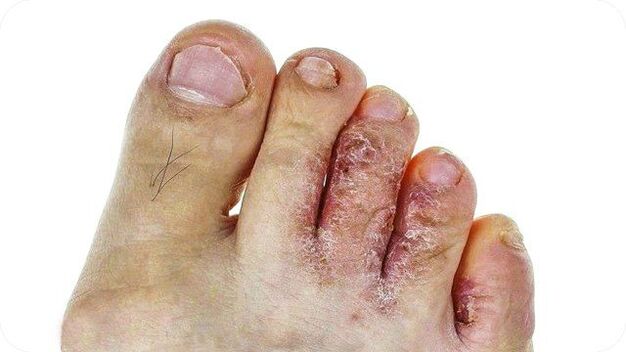
The classic form of rubrophytosis is characterized by redness and moderate thickening (lichenification) of the skin. The affected skin is shiny, with an increased pattern, a dry surface with flour-like scales that accumulate in the area of grooves and wrinkles.
Usually the disease begins with the third or fourth interdigital fold, which is the narrowest. The fungus then spreads to other spaces between the toes, the sole area and the back of the foot.
The following forms are characteristic of rubrophytia:
Commonly found:
- scaly form (main symptom is flaky skin),
- keratinizing form - the presence of "chickens", thickenings.
- intertriginous (opreloid),
- dyshidrotic (with blistering),
- Mixed form (diaper rash, blisters).
At the foot
Erased squamous rubrophytia has the least pronounced symptoms and goes almost unnoticed by the patient. Its main symptoms:
- Interdigital spaces: flaking, presence of mealy scales, superficial small cracks.
- There is practically no discomfort and a slight itching can be annoying.
In this form, rubrophytosis can last for quite a long time. However, a gradual progression of the disease can be observed, leading to the appearance of hyperkeratotic and mixed forms. Little by little there are:
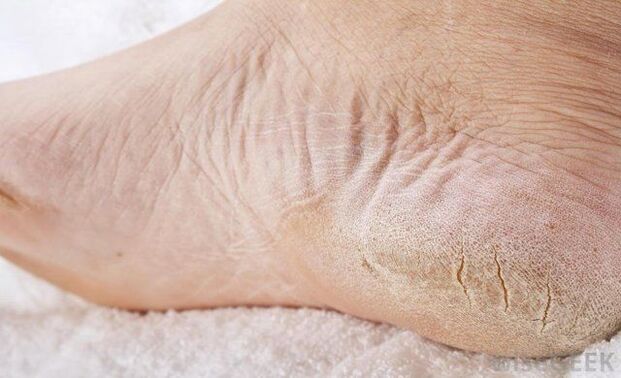
- increased dryness of the foot skin,
- roughening of the skin,
- the appearance of rough calluses on the sole and lateral areas of the foot,
- Formation of deep and painful cracks in the heel area.
With rubrophytosis of the feet, three main types of skin peeling are observed:
- Mealy.The natural wrinkles and furrows of the skin appear to be sprinkled with flour.
- Ring-shaped. Reddened patches with a border of exfoliated epithelium.
- Large lamellar. The skin peels off in large sheets.
In the interdigital spaces
When the feet sweat heavily, wearing poorly ventilated shoes or inadequate treatment, the spaces between the toes begin to become periodically wet. The skin swells, is eroded and has deep cracks. The main complaints of patients at this stage are itching, pain and burning.
Without timely and effective treatment, the process gradually worsens, manifested by increased pain and itching, which increases with movement. Large blisters form on the skin of the interdigital spaces and lateral surfaces of the fingers, which then turn into erosions and are surrounded by a rim of whitish epidermis.
On the nails
Nail plates of the toes with rubrophytosis:
- thickened,
- crumbles,
- yellowish gray or with a brown tint,
- chiseled white spots that subsequently spread to the entire nail.
Sometimes they detach from the nail bed, thicken and look like a bird's claw or an ingrown nail, causing additional discomfort to the patient.
Complications of rubrophytosis
As a rule, rubrophytia spreads to other parts of the body: hands, smooth skin, vellus hairs. The pathogen penetrates new areas of skin both lymphogenically and through contact (e. g. transmission via hands when washing feet).
- Hands – Damage to palms and nails.
- Smooth skin – lesions on the face, groin and thigh folds, buttocks and legs.
In this case, mycosis manifests itself as round pinkish-red or pinkish spots with a tendency to merge and grow peripherally. Their surface is covered with scales, and at the edges there is an inflammatory ridge with small bubbles and crusts.
If rubrophytia has spread to large wrinkles, itching occurs.
Athlete's foot: types and symptoms
Athlete's foot occurs much less frequently than rubrophytosis and has the same forms of the disease:
- Deleted.
- keratinizing.
- Diaper rash.
- With blistering.
- Nails of an athlete.
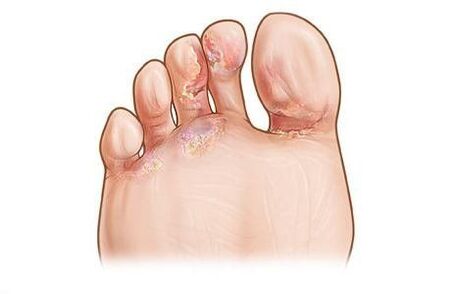
Plaque-like thickening of bluish-red skin then occurs on the side surfaces and soles of the feet. In the middle of the rash there are layers of scales, the boundaries of the lesions are clearly visible. In the spaces between the fingers, the epidermis takes on a whitish color.
With athlete's foot, patients suffer from itching, increased dryness and painful skin.
The opreloid (intertriginous) form of epidermophytosis is characterized by redness, swelling and maceration of the interdigital folds. Cracks often form and pain can be felt.
When the pathogen affects the arch of the foot, a dyshidrotic form can often be observed with the formation of blisters, which, when opened, look like wet erosions of pink or red color.
Athlete's foot most commonly occurs on the big toe (I) and little toe (V). In the thickness of the nail, closer to the free edge, yellowish spots and stripes form, which gradually increase and occupy the entire nail. Next, the nail begins to crumble and sometimes separates from the nail bed.
Acute epidermophytosis Podvysotskaya
The main symptoms of this form of athlete's foot:
- swelling of feet, fingers,
- abundance of bubbles,
- weeping erosions,
- maceration of interdigital folds,
- enlarged inguinal lymph nodes,
- increase in body temperature,
- Headache,
- difficulty walking due to pain,
- general weakness.
Onychomycosis of the toes: symptoms and types
In addition to the causative agents of rubrophytosis and epidermophytosis, onychomycosis can be caused by yeasts of the genus Candida, as well as some other fungi.
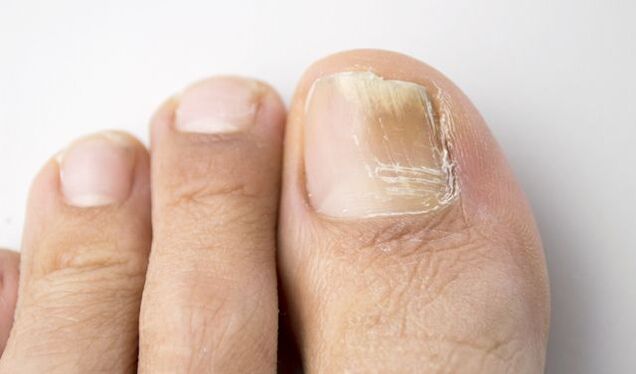
The most typical symptoms of onychomycosis that begin closer to the free edge of the nail:
- discoloration, loss of natural shine,
- thickening of the nail plate,
- the appearance of subungual hyperkeratosis,
- Destruction of the nail, detachment from the nail bed.
There are two main types of nail damage in onychomycosis:
- Normotrophic: White and yellowish stripes are visible in the thickness of the nail.
- Atrophic: thinning, destruction of the nail plate, detachment.
Diagnosis of fungal infections of the feet
A specialist in the treatment of fungal infections of the feet is a dermatologist who can involve other specialists in the treatment if necessary.
After talking with the patient, clarifying the complaints and the peculiarities of the occurrence and progression of the disease, the doctor will examine the affected surface and prescribe some additional examinations, for example:
- Microscopic examination with additional treatment of the material with potassium hydroxide.
- Woods lamp examination.
- Inoculation of suspicious biological material onto special media for the growth of fungi as well as media for bacteria.
Treatment
Treatment for athlete's foot infection must be prescribed by a doctor to achieve a complete cure.
In general, the treatment of foot mycoses is based on the following therapeutic principles:
- Fighting the infectious agent. In the initial stages of the disease, local medications are usually prescribed - antifungal ointments, creams, lotions. In severe cases, use systemic antifungals.
- Strengthening immunity and improving local blood circulation, treating the underlying disease.
- Desensitizing therapy. Since mycosis of the feet is often accompanied by allergic reactions, anti-allergic drugs are prescribed accordingly, which help to improve the patient's condition.
Treatment at home
- In order to effectively treat mycoses on the feet, it must be taken into account that fungi multiply in a moist environment. By excluding moisture, the development of fungi is prevented and the chances of healing increase.
- Protect your family members from fungal diseases. You should explain to them that from now on you are no longer allowed to go barefoot in the apartment, especially in the bathroom or shower room. After bathing or showering, it is necessary to treat the bath itself, the tray and the floor with a disinfectant.
- Wash your feet daily with soap and catch any pieces of skin that have fallen off with a napkin so that nothing gets under your nails.
- After washing your feet, be sure to dry the spaces between your toes with toilet paper or a hairdryer and then apply an antifungal medication prescribed by your doctor. Treatment must be continued for several months, even if the symptoms of mycosis disappear completely.
- Use powder when wearing shoes.
- Wear white cotton socks (clean daily). Used socks should be boiled or soaked in disinfectant for 10 minutes. Shoes must be disinfected with antifungal sprays.
Prevention of mycoses on the feet
Timely treatment of diseases that can weaken the body's defenses or impair blood circulation.
Diploma
Athlete's foot is one of the most common fungal skin infections. In most cases, following simple prevention rules helps to avoid the disease, and timely treatment begins to completely eliminate mycosis.



























